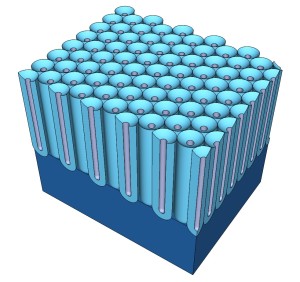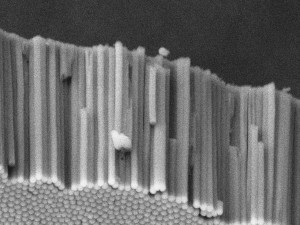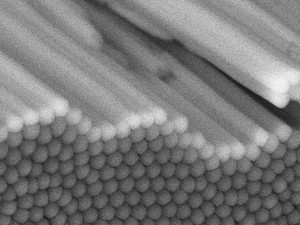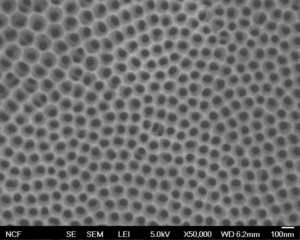Much like Aluminum, which can be manufactured into Anodic Aluminum Oxide (AAO), Titanium metal can be also electrochemically oxidized (or anodized) to form an ordered array of parallel nanotubes. The resulting nanotubular Anodic Titanium Oxide (ATO) materials are often referred to as Titania Nano Tubes (TNTs), or sometimes as TiO2 NTs. The name reflects the distinct structure of ATO, which typically appears as close-packed arrays of distinctly separate nanotubes (unlike AAO, where pores form hexagonal close-packed geometry without any gaps between individual cells).
It is generally recognized that Zwilling’s pioneering work in 1999 spurred the remarkable on-going interest in this material [1, 2]. Like the history of development for AAO, the development of ATO as a practical research material ha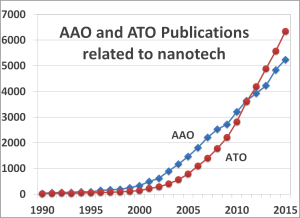 s seen two parallel fields of investigation evolve over time:
s seen two parallel fields of investigation evolve over time:
- Improvement in the understanding and development of titanium anodizing process (electrolyte composition, pretreatment of metal, anodizing potential, etc.), which has led to higher quality ATO materials.
- Exploration of the growing variety of applications for ATO, leveraging its fascinating and unique properties (optical, mechanical, thermal, biocompatibility, etc.).
Similar to AAO, by carefully selecting appropriate anodization conditions, ATO can be produced with a variety of tube diameters, lengths, and form factors (free standing ATO membranes, ATO films on Ti foil, etc.). The following ranges of dimensions were reported in the literature:
- Nanotube diameter: 15 nm – 500 nm
- Nanotube length: 100 nm – 100 um
For a recent comprehensive review, see Shmuki et al “One-Dimensional Titanium Dioxide Nanomaterials: Nanotubes”, Chemical Reviews, 2014, 114(19), pp 9385-9454. [iii]
ATO is actively being investigated for a huge variety of applications, including:
- Nanostructured cell culture substrates to improve cell activity
- Biofiltration
- Biocompatibility studies to improve dental and orthopedic implants
- Cancer cell killing when used in combination with low-dose UV light irradiation
- Localized drug delivery
- Dye-sensitized solar cells
- Photonic devices based on cathodoluminescence
- Novel electronic components (memristors)
- Highly efficient photocatalysts
- Purification of waste water via photoelectrocatalytic degradation
- Electrodes for photoelectrochemical cells
- Biosensors (here and here), chemical sensors (here and here)
- Energy storage
- electrodes for sodium ion and lithium ion batteries;
- electrodes for supercapacitors (here and here))

